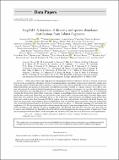FragSAD : a database of diversity and species abundance distributions from habitat fragments
Abstract
Habitat destruction is the single greatest anthropogenic threat to biodiversity. Decades of research on this issue have led to the accumulation of hundreds of data sets comparing species assemblages in larger, intact, habitats to smaller, more fragmented, habitats. Despite this, little synthesis or consensus has been achieved, primarily because of non-standardized sampling methodology and analyses of notoriously scale-dependent response variables (i.e., species richness). To be able to compare and contrast the results of habitat fragmentation on species’ assemblages, it is necessary to have the underlying data on species abundances and sampling intensity, so that standardization can be achieved. To accomplish this, we systematically searched the literature for studies where abundances of species in assemblages (of any taxa) were sampled from many habitat patches that varied in size. From these, we extracted data from several studies, and contacted authors of studies where appropriate data were collected but not published, giving us 117 studies that compared species assemblages among habitat fragments that varied in area. Less than one-half (41) of studies came from tropical forests of Central and South America, but there were many studies from temperate forests and grasslands from all continents except Antarctica. Fifty-four of the studies were on invertebrates (mostly insects), but there were several studies on plants (15), birds (16), mammals (19), and reptiles and amphibians (13). We also collected qualitative information on the length of time since fragmentation. With data on total and relative abundances (and identities) of species, sampling effort, and affiliated meta-data about the study sites, these data can be used to more definitively test hypotheses about the role of habitat fragmentation in altering patterns of biodiversity. There are no copyright restrictions. Please cite this data paper and the associated Dryad data set if the data are used in publications.
Citation
Chase , J M , Liebergesell , M , Sagouis , A , May , F , Blowes , S A , Berg , Å , Bernard , E , Brosi , B J , Cadotte , M W , Cayuela , L , Chiarello , A G , Cosson , J F , Cresswell , W , Dami , F D , Dauber , J , Dickman , C R , Didham , R K , Edwards , D P , Farneda , F Z , Gavish , Y , Gonçalves-Souza , T , Guadagnin , D L , Henry , M , López-Baucells , A , Kappes , H , Mac Nally , R , Manu , S , Martensen , A C , McCollin , D , Meyer , C F J , Neckel-Oliveira , S , Nogueira , A , Pons , J-M , Raheem , D C , Ramos , F N , Rocha , R , Sam , K , Slade , E , Stireman , J O , Struebig , M J , Vasconcelos , H & Ziv , Y 2019 , ' FragSAD : a database of diversity and species abundance distributions from habitat fragments ' , Ecology , vol. 100 , no. 12 , e02861 . https://doi.org/10.1002/ecy.2861
Publication
Ecology
Status
Peer reviewed
ISSN
0012-9658Type
Journal article
Collections
Items in the St Andrews Research Repository are protected by copyright, with all rights reserved, unless otherwise indicated.

